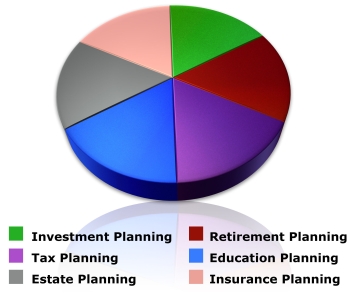Just what you need, right? One more time-consuming task to be taken care of between now and the end of the year. But taking a little time out from the holiday chores to make some strategic saving and investing decisions before December 31 can affect not only your long-term ability to meet your financial goals but also the amount of taxes you’ll owe next April.
Look at the forest, not just the trees
 The first step in your year-end investment planning process should be a review of your overall portfolio. That review can tell you whether you need to rebalance. If one type of investment has done well–for example, large-cap stocks–it might now represent a greater percentage of your portfolio than you originally intended. To rebalance, you would sell some of that asset class and use that money to buy other types of investments to bring your overall allocation back to an appropriate balance. Your overall review should also help you decide whether that rebalancing should be done before or after December 31 for tax reasons.
The first step in your year-end investment planning process should be a review of your overall portfolio. That review can tell you whether you need to rebalance. If one type of investment has done well–for example, large-cap stocks–it might now represent a greater percentage of your portfolio than you originally intended. To rebalance, you would sell some of that asset class and use that money to buy other types of investments to bring your overall allocation back to an appropriate balance. Your overall review should also help you decide whether that rebalancing should be done before or after December 31 for tax reasons.
Also, make sure your asset allocation is still appropriate for your time horizon and goals. You might consider being a bit more aggressive if you’re not meeting your financial targets, or more conservative if you’re getting closer to retirement. If you want greater diversification, you might consider adding an asset class that tends to react to market conditions differently than your existing investments do. Or you might look into an investment that you have avoided in the past because of its high valuation if it’s now selling at a more attractive price. Diversification and asset allocation don’t guarantee a profit or insure against a possible loss, of course, but they’re worth reviewing at least once a year.
Know when to hold ’em
When contemplating a change in your portfolio, don’t forget to consider how long you’ve owned each investment. Assets held for a year or less generate short-term capital gains, which are taxed as ordinary income. Depending on your tax bracket, your ordinary income tax rate could be much higher than the long-term capital gains rate, which applies to the sale of assets held for more than a year. For example, as of tax year 2015, the top marginal tax rate is 39.6%, which applies to any annual taxable income over $413,200 ($464,850 for married individuals filing jointly). By contrast, the long-term capital gains rate owed by taxpayers in the 39.6% tax bracket is 20%. For most investors–those in tax brackets between 25% and 35%–long-term capital gains are taxed at 15%; taxpayers in the lowest tax brackets–15% or less–are taxed at 0% on any long-term capital gains. (Long-term gains on collectibles are different; those are taxed at 28%.)
Your holding period can also affect the treatment of qualified stock dividends, which are taxed at the more favorable long-term capital gains rates. You must have held the stock at least 61 days within the 121-day period that starts 60 days before the stock’s ex-dividend date; preferred stock must be held for 91 days within a 181-day window. The lower rate also depends on when and whether your shares were hedged or optioned.
Three tips on year-end giving
- You may be able to sidestep capital gains taxes and get a deduction by making a charitable donation of securities that have risen in value but no longer fit your strategy.
- If you make a charitable donation of an investment that’s worth less than you paid, you can only deduct its market value, not what you paid for it. Ask your tax professional if you might be better off selling and deducting the loss.
- If you give appreciated securities to a child, keep in mind that the kiddie tax rules may apply, in which case annual investment income over $2,000 ($2,100 in 2015) will be taxed at your rate.
Make lemonade from lemons
 Now is the time to consider the tax consequences of any capital gains or losses you’ve experienced this year. Though tax considerations shouldn’t be the primary driver of your investing decisions, there are steps you can take before the end of the year to minimize any tax impact of your investing decisions.
Now is the time to consider the tax consequences of any capital gains or losses you’ve experienced this year. Though tax considerations shouldn’t be the primary driver of your investing decisions, there are steps you can take before the end of the year to minimize any tax impact of your investing decisions.
If you have realized capital gains from selling securities at a profit (congratulations!) and you have no tax losses carried forward from previous years, you can sell losing positions to avoid being taxed on some or all of those gains. Any losses over and above the amount of your gains can be used to offset up to $3,000 of ordinary income ($1,500 for a married person filing separately) or carried forward to reduce your taxes in future years. Selling losing positions for the tax benefit they will provide next April is a common financial practice known as “harvesting your losses.”
Example: You sold stock in ABC company this year for $2,500 more than you paid when you bought it four years ago. You decide to sell the XYZ stock that you bought six years ago because it seems unlikely to regain the $20,000 you paid for it. You sell your XYZ shares at a $7,000 loss. You offset your $2,500 capital gain, offset $3,000 of ordinary income tax this year, and carry forward the remaining $1,500 to be applied in future tax years.
Time any trades appropriately
If you’re selling to harvest losses in a stock or mutual fund and intend to repurchase the same security, make sure you wait at least 31 days before buying it again. Otherwise, the trade is considered a “wash sale,” and the tax loss will be disallowed. The wash sale rule also applies if you buy an option on the stock, sell it short, or buy it through your spouse within 30 days before or after the sale.
If you have unrealized losses that you want to capture but still believe in a specific investment, there are a couple of strategies you might think about. If you want to sell but don’t want to be out of the market for even a short period, you could sell your position at a loss, then buy a similar exchange-traded fund (ETF) that invests in the same asset class or industry. Or you could double your holdings, then sell your original shares at a loss after 31 days. You’d end up with the same position, but would have captured the tax loss.
If you’re buying a mutual fund or an ETF in a taxable account, find out when it will distribute any dividends or capital gains. Consider delaying your purchase until after that date, which often is near year-end. If you buy just before the distribution, you’ll owe taxes this year on that money, even if your own shares haven’t appreciated. And if you plan to sell a fund anyway, you may minimize taxes by selling before the distribution date.
Note: Before buying a mutual fund or ETF, don’t forget to consider carefully its investment objectives, risks, fees, and expenses, which can be found in the prospectus available from the fund. Read the prospectus carefully before investing.
A note on AMT
The lower tax rates on long-term capital gains and qualifying dividends apply to alternative minimum tax (AMT) calculations as well. However, because they’re included in calculating alternative minimum taxable income, large long-term gains and qualifying dividends can indirectly increase AMT exposure, and could potentially push you into the phaseout range for AMT exemptions. If this might affect you, talk to a tax professional.
Know where to hold ‘em
Think about which investments make sense to hold in a tax-advantaged account and which might be better for taxable accounts. For example, it’s generally not a good idea to hold tax-free investments, such as municipal bonds, in a tax-deferred account (e.g., a 401(k), IRA, or SEP). Doing so provides no additional tax advantage to compensate you for tax-free investments’ typically lower returns. And doing so generally turns that tax-free income into income that’s taxable at ordinary income tax rates when you withdraw it from the retirement account.
Similarly, if you have mutual funds that trade actively and therefore generate a lot of short-term capital gains, it may make sense to hold them in a tax-advantaged account to defer taxes on those gains, which can occur even if the fund itself has a loss. Finally, when deciding where to hold specific investments, keep in mind that distributions from a tax-deferred retirement plan don’t qualify for the lower tax rate on capital gains and dividends.
Be selective about selling shares
If you own a stock, fund, or ETF and decide to unload some shares, you may be able to maximize your tax advantage. For a mutual fund, the most common way to calculate cost basis is to use the average cost per share. However, you can also request that specific shares be sold–for example, those bought at a certain price. Which shares you choose depends on whether you want to book capital losses to offset gains, or keep gains to a minimum to reduce the tax bite. (This only applies to shares held in a taxable account.) Be aware that you must use the same method when you sell the rest of those shares.
Example: You have invested periodically in a stock for five years, paying various prices, and now want to sell some shares. To minimize the capital gains tax you’ll pay on them, you could decide to sell the least profitable shares, perhaps those that were only slightly lower when purchased. Or if you wanted losses to offset capital gains, you could specify shares bought above the current price.
Depending on when you bought a specific security, your broker may calculate your cost basis for you, and will typically designate a default method to be used. For stocks, the default method is likely to be FIFO (“first in, first out”); the first shares purchased are considered the first shares sold. As noted above, most mutual fund companies use the average cost per share as your default cost basis. With bonds, the default method amortizes any bond premium over the time you own the bond. You must notify your broker if you want to use a method other than the default.
IMPORTANT DISCLOSURES
Altum Wealth Advisors does not provide investment, tax, or legal advice via this website. The information presented here is not specific to any individual’s personal circumstances. To the extent that this material concerns tax matters, it is not intended or written to be used, and cannot be used, by a taxpayer for the purpose of avoiding penalties that may be imposed by law. Each taxpayer should seek independent advice from a tax professional based on his or her individual circumstances. These materials are provided for general information and educational purposes based upon publicly available information from sources believed to be reliable—we cannot assure the accuracy or completeness of these materials. The information in these materials may change at any time and without notice.
CIRCULAR 230 NOTICE: To ensure compliance with requirements imposed by the IRS, this notice is to inform you that any tax advice included in this communication, including any attachments, is not intended or written to be used, and cannot be used, for the purpose of avoiding any federal tax penalty or promoting, marketing, or recommending to another party any transaction or matter.
Prepared by Broadridge Investor Communication Solutions, Inc. Copyright 2016.
Prepared for Altum Wealth Advisors, Steven Cliadakis, MBA, CFP®, AIF®, Managing Director, Wealth Strategist.
 Nearly three quarters of workers and 77% of retirees in a recent survey said they remain at least somewhat confident that they will experience a comfortable retirement, according to the Employee Benefit Research Institute. Nevertheless, a third of workers and a quarter of retirees felt less confident this year due to the economic effects of the COVID-19 pandemic, with many respondents citing inflation as the reason.
Nearly three quarters of workers and 77% of retirees in a recent survey said they remain at least somewhat confident that they will experience a comfortable retirement, according to the Employee Benefit Research Institute. Nevertheless, a third of workers and a quarter of retirees felt less confident this year due to the economic effects of the COVID-19 pandemic, with many respondents citing inflation as the reason.


 Losing a loved one can be a difficult experience. Yet, during this time, you must complete a variety of tasks and make important financial decisions.
Losing a loved one can be a difficult experience. Yet, during this time, you must complete a variety of tasks and make important financial decisions. Initial tasks
Initial tasks
 The 2015 Budget Bill, signed into law on November 2nd, will put an end to two popular Social Security claiming loopholes associated with the restricted application and file-and-suspend claiming options.
The 2015 Budget Bill, signed into law on November 2nd, will put an end to two popular Social Security claiming loopholes associated with the restricted application and file-and-suspend claiming options.




 Even if the value of your holdings fluctuates, regularly adding to an account designed for a long-term goal may cushion the emotional impact of market swings. If losses are offset even in part by new savings, your bottom-line number might not be quite so discouraging.
Even if the value of your holdings fluctuates, regularly adding to an account designed for a long-term goal may cushion the emotional impact of market swings. If losses are offset even in part by new savings, your bottom-line number might not be quite so discouraging.





